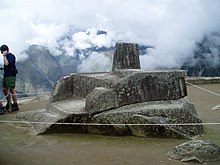 Intihuatana | |
| Alternative name | Hitching post of the Sun |
|---|---|
| Location | Peru |
| Region | Cusco Region, Urubamba Province |
| Coordinates | 13°09′54″S 72°32′44″W / 13.1651°S 72.5455°W |
| History | |
| Founded | c. 1450 |
| Abandoned | ~ 1535 |
| Cultures | pre-Inca ("megalithic"); Inca |
| Associated with | up to 800 at peak |
Intihuatana (possibly from in the Quechua spelling Inti Watana or Intiwatana)[1][2] at the archaeological site of Machu Picchu (Machu Pikchu) is a notable ritual stone associated with the astronomic clock or calendar of the Inca in South America. Machu Picchu was thought to have been built c. 1450 by the Sapa Inca Pachacuti as a country estate.[3] In the late 16th century, the Viceroy Francisco de Toledo and the clergy destroyed those Intihuatana which they could find. They did so as they believed that the Incas' religion was a blasphemy[4] and the religious significance of the Intihuatana could be a political liability. The Intihuatana of Machu Picchu was found intact by Bingham in 1911, indicating that the Spanish conquerors had not found it.[5] Intihuatana was damaged on September 8, 2000 when a crane being used in an ad shoot toppled over and chipped off a piece of the granite.[6]
- ^ Teofilo Laime Ajacopa, Diccionario Bilingüe Iskay simipi yuyayk'ancha, La Paz, 2007 (Quechua-Spanish dictionary)
- ^ Diccionario Quechua - Español - Quechua, Academía Mayor de la Lengua Quechua, Gobierno Regional Cusco, Cusco 2005 (Quechua-Spanish dictionary)
- ^ "Pachacuti Inca Yupanqui - Inca emperor". britannica.com.
- ^ Amao, Albert (23 January 2012). The Dawning of the Golden Age of Aquarius. AuthorHouse. pp. 79–. ISBN 978-1-4685-3753-6. Retrieved 19 July 2012.
- ^ Krupp, E. C. (5 August 2003). Echoes of the Ancient Skies: The Astronomy of Lost Civilizations. Courier Dover Publications. pp. 48–. ISBN 978-0-486-42882-6. Retrieved 19 July 2012.
- ^ "Peasants Protest at Machu Picchu". ABC News. Retrieved 5 January 2014.

